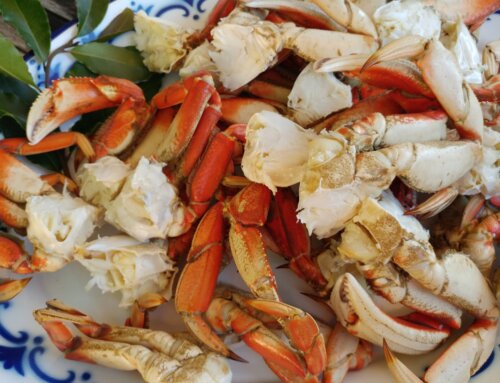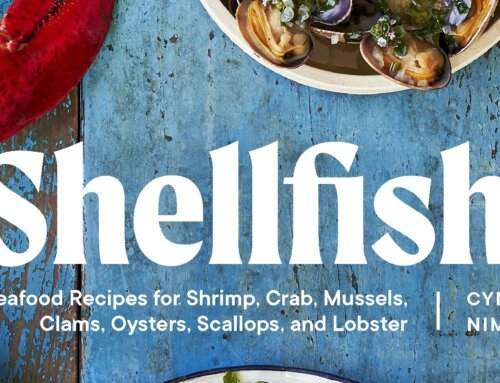I hesitate to call the books that surround me on my home office a collection, exactly. I have no organized plan or focus around acquiring books, which I tend to associate with the idea of collecting things–stamps, wine, antiques. As a random assemblage of books, however, it ideally suits me and reflects my interests, my personality and my career. Which is perhaps precisely what we should ask of our cookbook shelves, so for that I need to embrace it as a collection without hesitation or qualifiers.
My array of books is not nearly as big as the some avid collectors, it’s in the 500 to 600 range based on what’s logged on  my Eat Your Books account. Oh, I’d be capable of more, no question about it. I’m very good at keeping things. But given the real, tangible space books occupy and my lack of endless room for storing them, I’ve made a deal with myself. Essentially when new books come in, something surely will get culled–or moved to one of the overflow shelves in a bedroom or the basement, where in turn something will end up in the donate box to make room for the newcomer.
my Eat Your Books account. Oh, I’d be capable of more, no question about it. I’m very good at keeping things. But given the real, tangible space books occupy and my lack of endless room for storing them, I’ve made a deal with myself. Essentially when new books come in, something surely will get culled–or moved to one of the overflow shelves in a bedroom or the basement, where in turn something will end up in the donate box to make room for the newcomer.
I’ll say that as a food writer, I use my cookbook collection as much for research as for cooking, if not more. When I make dinner for my husband and me (which has been a MUCH more frequent occurrence in these quarantine months, I know all can relate) it’s generally just off-the-cuff cooking. Familiar ingredients, techniques, ideas I draw from having spent so much time in the kitchen. Even when I do turn to cookbooks for inspiration, I’ll admit to often still riffing on the original recipe, based on ingredients I want to use, taste preferences or just playing around with the idea.
So what is on my shelves? Here goes a brief overview.
A good chunk of them focus on regional United States and world cuisines. These are key for the research element, and my general love of the cultural importance certain ingredients and preparations have in specific parts of the country and the world. Given my personal story, there are more books of French cuisine than others–though echoing my earlier note, it’s far from exhaustive. Certainly books featuring Northwest cuisine and ingredients are well represented. A treasure among these regional books is my Time-Life Foods of the World series, of which I’ve managed to attain all but one of the 27 hardbound books, and half or more of the spiral-bound recipe supplements.
I cut my teeth as a food writer at Simply Seafood magazine, right after returning home to Seattle from my 2 1/2 years studying and working at La Varenne in France. That was a while ago, yes, but seafood has remained an area of special interest, two cookbooks I most recently wrote echoing that: Oysters and Crab. So I have a decent selection of seafood titles in the mix.
Sometimes it’s as much the esthetic of a book as its recipe content that draws me–I trust others can relate, each with our own stylistic motivations. Mine is for all things mid-century retro. I love my 1956 house, I love design elements from that era, the cocktail party/jazz motifs, films like Auntie Mame (Rosalind Russell, of course) and Rear Window. So when scanning shelves of a book store, I will most always give in to interesting cookbooks from that general era. Esquire’s Handbook for Hosts, Trader Vic’s Book of Food & Drink, James Beard’s Hors d’Oeuvres and Canapés among this subset.
The rest cover an array of themes and eras. I love Mediterranean cuisine, it’s a frequent point of departure for dinners around here. So I turn often to books from Paula Wolfert and Yotam Ottalenghi. Speaking of Paula Wolfert, her Couscous and Other Good Food From Morocco was among the first cookbooks I got, shortly after college, that dealt with a passionate, personal expression of a world cuisine. After coming home from study abroad in France, where I and my college pals ate our share of inexpensive, exotic, delicious couscous on our meager student budgets, it helped hold on to the joys of that time and those meals.
Would you believe I still have yet to step foot in Morocco myself? The beauty of a great cookbook like that is the virtual travel experience it offers. Something we’re all appreciating more than ever as we’ve been sequestered in our home kitchens channeling our wanderlust through recipes with global roots. Oh, and also speaking of Paula Wolfert, one very favorite new addition to my repertoire is from her book Unforgettable, which is a beautiful testament to her full arc of experience and adventure, in her work and in the kitchen. Her Mint and Egg Salad is pretty simple–hard-cooked eggs, tons of fresh mint, green onion, chile flakes, olive oil, lemon juice–but so delicious and vibrant.
A couple of my more recent additions are Cool Beans by Joe Yonan and Flour Water Salt Yeast by Ken Forkish. A big big fan of chickpeas in all forms, in Joe’s book it’s little surprise I went directly for the Chickpea Cake with Mushrooms recipe, which I’ve made a couple of times. And I look forward to expanding my repertoire with other beans as I work my way through other recipes in the book. (A perpetually-novice gardener, my recently planted beans seem to be doing pretty well so far: scarlet runners, favas and verdinas brought home from Spain.)
As for FWSY — yes, I’m among those who have gone full force with quarantine bread baking. Though I’d gotten a bit of a head start, having spent a full day cooking with a bread-fanatic friend early this year before realizing it might prove to be a functional exercise and not just a fun new thing to learn. (I went all in, buying two 50-pound bags of locally milled heritage grain flour, all-purpose and whole wheat, to supply my new habit.) This book has great information to help understand techniques and processes, though I find recipes seem to have more advanced bakers in mind. Still, it’s a solid new resource I’m happy to have on my shelves.
Another couple years and the mix may be a bit different. I guess that’s another trait of a good cookbook collection: it’s in on-going evolution.




